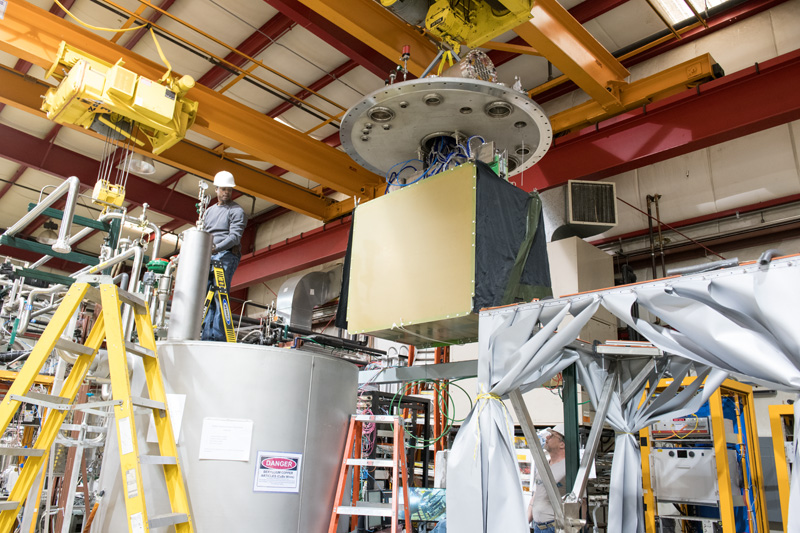Sep 21 2020
Hosted by Fermilab, the international Deep Underground Neutrino Experiment, or DUNE for short, is anticipated to be very huge. As a matter of fact, with over 1,000 collaborators from above 30 nations and five continents, the event is the greatest international science project to be hosted in the United States.
 Fermi lab’s ICEBERG particle detector is effectively a miniature version of component that tracks neutrinos in the international Deep Underground Neutrino Experiment, hosted by Fermilab. ICEBERG researchers confirm that the detector components for DUNE reach the specifications necessary for that experiment to be successful. Image Credit: Reidar Hahn, Fermilab.
Fermi lab’s ICEBERG particle detector is effectively a miniature version of component that tracks neutrinos in the international Deep Underground Neutrino Experiment, hosted by Fermilab. ICEBERG researchers confirm that the detector components for DUNE reach the specifications necessary for that experiment to be successful. Image Credit: Reidar Hahn, Fermilab.
To prepare for this huge endeavor, the particle physics community has been taking DUNE technologies for comprehensive test drives. In the past 10 years, the ProtoDUNE detectors deployed at CERN and the particle detectors LArIAT, ICARUS, and MicroBooNE deployed at Fermilab have all contributed considerably to compile the deep background knowledge required to build and use DUNE—a neutrino detector that will utilize sophisticated electronics and liquid argon to capture the passage of the well-known mysterious particles.
DUNE preparations entered a new stage in 2019, as Fermilab founded a new testing facility for DUNE detectors—the ICEBERG, short for Integrated Cryostat and Electronics Built for Experimental Research Goals.
DUNE’s primary goal is to measure and understand very particular properties of the neutrino, and ICEBERG is a facility where we can confirm that the detector components we’re designing reach the specifications necessary for DUNE to be successful.
Rory Fitzpatrick, Graduate Student, University of Michigan
Fitzpatrick is working on the photon detectors of ICEBERG.
Neutrinos are the most abundant matter particles present in the universe. They offer a handy testing ground for particle physics theories, but they barely cooperate with anything, and hence, they tend to oscillate between three different states while traveling.
Physics experiments, like DUNE, use the characteristics of neutrinos to shed light on the differences between antimatter and matter, perhaps describing why the universe appears to be controlled by matter. In addition, neutrinos may teach individuals about the lifetime of proton and the formations of black holes along the way.
Fermilab accelerators are capable of shooting an underground beam of neutrino particles 800 miles via the Earth’s crust—from Fermilab based in Illinois to the Sanford Underground Research Facility located in South Dakota.
At each location, a detector will quantify the composition of the beam and examine how the neutrino particles have shape-shifted along their flight. Since neutrinos interact quite weakly, the detectors need to be ultrasensitive and massive.
Liquid Argon
In essence, neutrinos are massive tubs of liquid argon that get hit with the small particles. Sometimes, one of the neutrinos will communicate with the argon and create photons and charged particles, both of which are identified by numerous sensors in the DUNE detector. The detector in ICEBERG is actually a miniature model of the DUNE component that follows these particles.
Highly elusive neutrinos do not have to be sent to particle detectors, and the functionality of the system can be easily tested. When the detectors are stationed above the ground, they can also detect traces from cosmic rays—produced when high-energy particles from outer space strike the atmosphere—relatively more consistently.
Though the cosmic-ray signatures, physicists can test check the DUNE electronics above ground with photon-detection and charge-tracking systems. In addition, since the cosmic rays are abundantly present on the surface of the Earth and also easier to identify than neutrinos, the models can be smaller and need relatively less precious argon.
The liquid argon utilized for ICEBERG would fill the bed of a pickup vehicle. By comparison, DUNE needs argon that is sufficient to fill 12 Olympic-sized swimming pools. DUNE scientists are presently checking the second of many combinations of new and establishedelectronics with ICEBERG.
The scientists, engineers and technical staff work together to find ways to continually improve the ICEBERG and keep its entire support infrastructure running.
Kelly Hardin, Technician, Fermilab
Hardin works on all liquid-argon detectors at Fermilab.
Once this sequence of tests stops, the selected photon sensors and electronics are anticipated to be tested in one of the ProtoDUNE detectors prior to being produced in a large scale for use in DUNE.
So far, the whole ICEBERG detector and associate infrastructure are operating properly. The measurements are coming out very nice. We’ve seen beautiful tracks and detected photons.
Shekhar Mishra, Scientist, Fermilab
Mishra is also the ICEBERG project lead.
The procedure of operating and controlling this and other model detectors will allow researchers to prepare for the big league—DUNE. A global project of its size needs rigorous assurance checks and complete preparation.
ICEBERG has given me a chance to get my hands dirty and turn some screws. It amazes me how much coordination is required for a detector as small as ICEBERG, let alone DUNE itself.
Ivan Caro Terrazas, Graduate Student, Colorado State University
Terrazas is also working on ICEBERG’s particle-tracking systems.
In several ways, ICEBERG serves as a crystal ball for DUNE—providing insight on its upcoming barriers and needs.
“Even by running ICEBERG, a micro-DUNE, we’re learning a lot about what we’re going to need to build, operate and manage this massive detector. ICEBERG is a collaborative effort of laboratories and institutions around the globe. We rely on our diverse team to push through challenges and accomplish our goals, concluded Mishra.